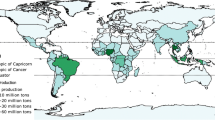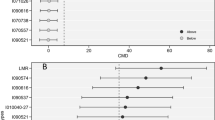Abstract
Cassava (Manihot esculenta Crantz) is a cyanide-containing root crop used by many indigenous groups in Amazonia. Despite the availability of low-cyanogenic potential (CNP) cassava, the Tukanoans of the Colombian Amazon region and many other indigenous groups in lowland Amazonia cultivate primarily high-CNP cassava as their staple crop. Based on the assumption that the Tukanoan preference for high-CNP cultivars is due, in part, to the ability of these cultivars to consistently produce higher yields, we tested the null hypothesis that low-CNP cassava has yields that are greater than or equal to the yields of high-CNP cultivars in Tukanoan gardens. To do so we compared the yields of low- and high-CNP cassava in 10 Tukanoan gardens and in one control garden. We reject the null hypothesis: high-CNP cultivars yielded more than low-CNP cultivars in both traditional Tukanoan Indian gardens and a control garden. Although there are several possible explanations for the differences in yields, the most plausible inference is that the high-CNP plants are more likely to be disease and/or insect resistant.
Resumen
La yuca o mandioca (Manihot esculenta Crantz) es una raíz comestible que contiene cianuro, utilizada por numerosos grupos indígenas en la Amazonia. A pesar de que existe una variedad de yuca de bajo contenido en cianuro (CNP), los Tukanos de la región amazónica colombiana y muchos otros grupos indígenas en las tierras bajas del Amazonas cultivan principalmente la variedad de yuca con alto contenido en cianuro como alimento básico. Basándonos en la presunción de que la preferencia de los Tukanos por los cultivos de yuca de alto contenido en cianuro, se debe, en parte, a que esta variedad produce mayores rendimientos, intentamos comprobar la hipótesis de que la yuca de bajo contenido en cianuro logra rendimientos iguales o mayores que los de los cultivos de alto contenido en cianuro que realizan los Tukanos. Para ello, comparamos los rendimientos de la yuca de alto y de bajo contenido en cianuro en diez huertos de los Tukanos y en un huerto de control. Debemos descartar la hipótesis: los cultivos de alto contenido en cianuro rindieron más que los de bajo contenido, tanto en los huertos tradicionales de los indígenas como un el huerto de control. Aunque existen varias explicaciones posibles para esta diferencia en rendimiento, la más plausible es que las plantas con alto contenido de cianuro poseen mayor resistencia a los insectos y a las enfermedades.
Similar content being viewed by others
Literature Cited
Alvarado, J. N. 1982. Considerations on the Colombian Amazon region.In S. B. Hecht, ed., Amazonia: agriculture and land use, Proceedings of the First International Conference on Amazonian Agriculture and Land Use Research, CIAT 1980, Centro Internacional de Agricultura Tropical, Cali, Colombia.
Bellotti, A. C., andV. B. Arias. 1993. Possible role of HCNB in the biology and feeding behavior of the cassava burrowing bug (Cyrtomenus bergi Froeschner: Cynidae: Hemiptera). Pages 406–409in W. M. Roca and A. M. Thro, eds., Proceedings of the Cassava Biotechnology Network: First International Scientific Meeting of the Cassava Biotechnology Network, Centro Internacional de Agricultura Tropical (CIAT), Cali, Colombia.
—————. 1978a. Cassava pests and their control. CIAT, Colombia.
—————, and —————.. 1978b. Mite and insect pests of cassava. Annual Review of Entomology 23:39–67.
Best, R., andT. R. Hargrove. 1993. Cassava: the latest facts about an ancient crop. Centro International de Agricultura Tropical (CIAT), Cali, Colombia.
Boster, J. S. 1984. Classification, cultivation, and selection of Aguaruna cultivars ofManihot esculenta (Euphorbiaceae). Pages 34–47in G. T. Prance and J. A. Kallunki, eds., Ethnobotany in the Neotropics advances in economic botany 1:34–47. New York Botanical Garden, Bronx, New York.
Bunyard, P. 1989. The Columbian Amazon: policies for the protection of its indigenous peoples and their environment. The Ecological Press, Bodmin, Cornwall, UK.
Chernela, J. M. 1987. Os cultivares de mandioca na area do Uaupes (Tukano). Pages 151–158in B. Ribiero, ed. SUMA: Etnologia Brasiliera, I, Etnobiologia, FINEP, Petropolis.
Cooke, R. D. 1983. Effects of cassava processing on residual cyanide. Pages 138–142in F. Delange and R. Ahluwalia, eds., Cassava toxicity and thyroid: research and public health issues, Proceedings of a workshop held in Ottawa, Canada, 31 May–2 June 1982. IRDC-207e, Ottawa, Canada.
Coursey, D. G., andR. H. Booth. 1977. Root and tuber crops. Pages 75–96in C. L. A. Leakey and J. B. Wills, eds., Food crops of the lowland tropics. Oxford University Press, Oxford.
Dixon, A. G., R. Asiedu, andM. Bokanga. 1994. Breeding of cassava for low cyanogenic potential: problems, progress, and prospects. Acta Horticultura 375:153–161.
Dufour, D. L. 1983. Nutrition in the Northwest Amazon: household dietary intake and time energy expenditure. Pages 329–356in R. B. Hames and W. T. Vickers, eds., Adaptive responses of native Amazonians. Academic Press, Inc., NY.
————— 1988a. Cyanide content of cassava (Manihot esculenta, Euphorbiaceae) cultivars used by Tukanoan Indians in Northwest Amazonia. Economic Botany 42:255–66.
————— 1988b. The composition of some foods used in Northwest Amazonia. Interciencia. 13:83–86.
————— 1989. Effectiveness of cassava detoxification techniques used by indigenous peoples in Northwest Amazonia. Interciencia. 14:86–91.
-----. 1993. The bitter is sweet: a case study of bitter cassava (Manihot esculenta) use in Amazonia. Pages 575–588in C. M. Hladik, A. Hladik, O. F. Linares, H. Pagezy, A. Semple, and M. Hadley, eds., Food and nutrition in tropical forests: biocultural interactions. Volume 13, Man in the Biosphere Series Paris, UNESCO/Parthenon.
—————. 1996. La douceur de l’amertume: une ré-évaluation des choix du \ manioc amer par les Indiens Tukano d’ Amazonie. Pages 875–896in C. M. Hladik, A. Hladik, O. F. Linares, H. Pagezy, A. Semple, and M. Hadley, eds., L’alimentation en foret tropical: interactions bioculturelles et applications au developpement. UNESCO/Parthenon Press, Paris.
Hughes, M. A., andA. Esen. 1993. Molecular genetics of plant cyanogenic beta-glucosidases. Beta-—glucosidases: biochemistry and molecular biology. 204th National meeting of the American Chemical Society, 23–28 August 1992, Washington D.C., American Chemical Society, Washington, D.C.
Johns, T. 1990. With bitter herbs they shall eat it: chemical ecology and the origins of human diet and medicine. University of Arizona Press, Tucson.
Kakes, P. 1990. Properties and functions of cyanogenic systems in higher plants. Euphytica 48:25–43.
Kapinga, R., N. Malingi, andH. Rosling. 1997. Reasons for use of bitter cassava—a study of cassava in Mtwara region, Tanzania. Proceedings of the Third International Scientific Meeting of the Cassava Biotechnology Network. 26–30 August 1996, Kampala, Uganda, African J. Root and Tuber Crops, ISTRC, Ibadan, Nigeria.
Keresztessy, Z., L. Kiss, andM. A. Hughes. 1994a. Investigation of the active site of the cyanogenic beta-D-glucosidase (linamarase) fromManihot esculenta Crantz (cassava). I. Evidence for an essential carboxylate and a reactive histidine residue in a single catalytic center. Archives of Biochemistry and Biophysics 314:142–152.
—————, —————, and —————. 1994b. Investigation of the active site of the cyanogenic beta-D-glucosidase (linamarase) fromManihot esculenta Crantz (cassava). II. Identification of Glu-198 as an active site carboxylate group with acid catalytic function. Archives of Biochemistry and Biophysics 315:323–330.
McKey, D., and S. Beckerman. 1993. Chemical ecology, plant evolution and traditional cassava cultivation systems. Pages 83–112in C. M. Hladik, A. Hladik, O. F. Linares, H. Pagezy, A. Semple, and M. Hadley, eds., Food and nutrition in tropical forests: biocultural interactions. Volume 13, Man in the Biosphere Series Paris, UNESCO/Parthenon.
McMahon, J. M., W. L. B. White, andR. T. Sayre. 1995. Cyanogenesis in cassava (Manihot esculenta Crantz). Journal of Experimental Botany 46(288):731–741.
Microsoft Corporation. 1994. Excel 4.0, Redmond, WA.
O’Brien, G. M., C. C. Wheatley, C. Iglesias, andN. H. Poulter. 1994. Evaluation, modification, and comparison of two rapid assays for cyanogens in cassava. Journal of the Science of Food and Agriculture 65:391–399.
Pollard, A. J. 1992. The importance of deterrence: responses of grazing animals to plant variation. Pages 216–239in R. S. Fritz and E. L. Simms, eds., Plant resistance to herbivores and pathogens: ecology, evolution, and genetics. University of Chicago Press, Chicago.
Purseglove, J. W. 1968. Tropical crops. Dicotyledons. 2 Volumes. Longmans Green and Co., London.
Riis, L. 1997. Behaviour and population growth of the Burrower Bug,Cyrtomenus bergi Froeschner: effects of host plant and abiotic factors. Ph.D. dissertation, Royal Veterinary and Agricultural University Copenhagen, Denmark.
Seigler, D. S., andJ. F. Pereira. 1981. Modernized preparation of cassava in the Llanos Orientales of Venezuela. Economic Botany 35:356–362.
Silvestre, P., andM. Arrandeau. 1983. Le manioc: techniques agricoles et productions tropicals, 32, Maisonneuve et LaRose, Paris.
Simms, E. L. 1992. Costs of plant resistance to herbivory. Pages 392–425in R. S. Fritz and E. L. Simms, eds., Plant resistance to herbivores and pathogens: ecology, evolution, and genetics. University of Chicago Press, Chicago.
Thro, A. M., M. Msabaha, H. Kulembeka, W. Shengero, A. Kapande, N. Mlingi, L. Hemed, P. Digges, andJ. Cropley. 1995. Village perspective on cassava: CBN case study in Tanzania. Pages 28–35in Proceedings, Second International Meeting of the Cassava Biotechnology Network, 22–26 August 1994. Bogor, Indonesia, Centro Internacional de Agricultura Tropical (CIAT), Cali, Colombia.
Toro, J. C., andA. Cañas. 1976. Determinacion del contenido de materia seca y almidon en yuca por el sistema de gravidad especifica. Pages 567–575in Carlos and Dominguez, eds., Yuca: investigación, producción, y utilización. Centro Internacional de Agricultura Tropical (CIAT), Cali, Colombia.
Uhl, C. 1980. Studies of forest, agriculture, and successional environments in the Upper Rio Negro region of the Amazon Basin. Ph.D. thesis, Michigan State University.
UNESCO (United Nations Educational, Scientific, and Cultural Organization). 1990. Vegetation map of South America. UNESCO, Toulouse, France.
Wilson, W. M. 1997. Why bitter cassava (Manihot esculenta Crantz)? Productivity and perception of cassava in a Tukanoan Indian settlement in the Northwest Amazon, Ph.D. dissertation, University of Colorado at Boulder.
Zangerl, A. R., andF. A. Bazzaz. 1992. Theory and pattern in plant defense allocation. Pages 363–391in R. S. Fritz and E. L. Simms, eds., Plant resistance to herbivores and pathogens: ecology, evolution, and genetics. University of Chicago Press, Chicago.
Author information
Authors and Affiliations
Corresponding author
Rights and permissions
About this article
Cite this article
Wilson, W.M., Dufour, D.L. Why “Bitter” cassava? Productivity of “Bitter” and “Sweet” cassava in a Tukanoan Indian settlement in the Northwest Amazon. Econ Bot 56, 49–57 (2002). https://doi.org/10.1663/0013-0001(2002)056[0049:WBCPOB]2.0.CO;2
Received:
Accepted:
Issue Date:
DOI: https://doi.org/10.1663/0013-0001(2002)056[0049:WBCPOB]2.0.CO;2




